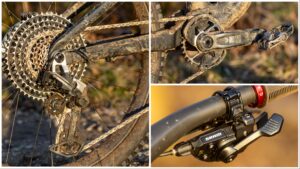Cannondale has totally nailed the fit and sizing on the Habit 5
Cannondale Habit 5 (2017) review
Most trail bikes sit squarely between XC and Enduro. The Habit, however, has much more in common with Cannondale’s short-travel Scalpel than the split-personality Jekyll that’s been so dominant at the Enduro World Series.

Travel has been increased by 20mm over the Scalpel to deliver 120mm, and the wheel size has been reduced from 29in to 27.5in.
The Habit frame also shares Cannondale’s Zero Pivot swingarm, which uses flex in the seatstays to eliminate the bearings and associated pivot hardware and save weight. That’s the idea at least, but even with all of that clever aluminium manipulation, the Habit is not the lightest bike in this test — that honour goes to the Giant Trance.
Other neat features on the frame include an injection-moulded carbon upper link, with the shock tucked neatly under the top tube to place the threshold lever on the RockShox Monarch RT within easy reach.
And, even though Cannondale’s signature Lefty fork isn’t present on the Habit 5, the oversized 1.5in head tube is, so you could always retrofit one at a later date. This also makes it easier to run an angle adjust headset if you wanted to change the geometry. All in all, the frame is a sleek, purposeful design.

Injection-moulded carbon upper link gives 120mm of travel
Suspension
Because the seatstay assembly doesn’t have bearings, it acts like an undamped aluminium leaf spring. Cannondale, however, has done a good job of controlling the amount of stored energy the flex stays produce, so there’s no need to run the rebound damping overly slow on the Monarch RT shock to compensate. And with the main pivot just above the bottom bracket, and the upper link gliding on cartridge bearings, the 120mm travel is sensitive, even with its distinct bias toward pedalling efficiency.

Recon Gold fork is the most sure-footed on test
Up front, the Habit 5 gets a RockShox Recon Gold RL suspension fork, also with 120mm travel. Being the Gold level fork, the range of rebound adjustment is better than on the Silver tier RockShox units found on the Giant and Trek. The Recon also benefits from lighter aluminium upper tubes, but as we mentioned earlier, it’s still not the lightest bike, despite having the least amount of suspension travel on test.
Components
Cannondale has put together a great package for the Habit 5. The 760mm handlebar has a good profile, and combined with lock-on grips and 60mm stem, the cockpit certainly isn’t wanting.
What this bike really needs, however, is a quick-release seat collar. We said as much last time when we tested the Bad Habit Plus hardtail, as rummaging for a multi-tool every time you want to adjust your saddle height gets boring very quickly. And this is even more important with the Habit 5, as it sports the most head down, bum up riding position of the four bikes in test. Also, with all of the scratch marks on the seatpost, it makes your new bike look old very quickly.

Zero Pivot design eliminates hardware and saves weight
Performance
The Habit rides every bit as sharp as it looks, and reacts to rider inputs faster than the blink of an eye. It doesn’t squat when you get on the gas, and because the chainstays are much lower than the rear dropouts, there’s very little chain slap, meaning the bike is really quiet even on the roughest trails.
With only 120mm travel, however, it doesn’t have the surefooted suspension response of the other bikes in test. As such, it’s not the sort of bike where you preload the suspension in one corner to bounce into another, but even with its more direct ride quality, the Habit still favours a skilled rider.
It’s basically an XC bike on steroids. If you’re looking to make the jump from a pure XC race bike to something more capable, the Habit is the perfect stepping stone, as it still pedals really efficiently but it will allow you to push your limits further on more challenging terrain. Also, you’ll probably be less bothered about the inability to lower your saddle quickly.

Verdict
First and foremost, Cannondale has totally nailed the fit and sizing on the Habit 5. The 60mm stem perfectly complements the generous frame proportions on the size large bike, and the 760mm handlebar boosts confidence and control further. Frame finish is also first rate, but given that it was the shortest travel bike on test, with the most XC-focused attitude, we expected it to be the lightest… it wasn’t. Sure, the tighter suspension response makes it feel fast, efficient and fun to ride, but if you’re expecting the bike to do most of the work for you, there are better options in this test.
















